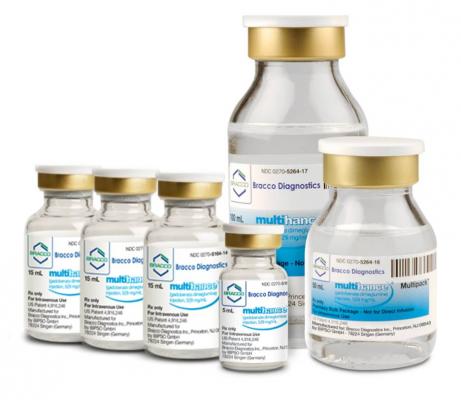
January 30, 2018 — Bracco Diagnostics Inc. announced the labeling of its contrast agent MultiHance has obtained U.S. Food and Drug Administration (FDA) approval for an extension to include magnetic resonance imaging (MRI) of the central nervous system (CNS) in pediatric patients younger than 2 years of age (including term neonates). The agent may now be used in this patient population to visualize lesions with abnormal blood-brain barrier or abnormal vascularity of the brain, spine and associated tissues.
The approval was based on data specifically obtained in pediatric patients younger than 2 years of age. Similar to older pediatric patients and adults, a dose of 0.1 mmol/kg was shown to significantly improve the visualization and morphologic assessment of CNS lesions. In neonates and infants, however, a dose of 0.05 mmol/kg is effective at improving the visualization of lesions in the brain and the spine. This provides healthcare professionals with dosing flexibility depending on patient and imaging conditions and needs.
MultiHance (gadobenate dimeglumine) injection, 529 mg/mL is a gadolinium-based contrast agent indicated for intravenous use in:
- MRI of the central nervous system (CNS) in adults and pediatric patients (including term neonates), to visualize lesions with abnormal blood-brain barrier or abnormal vascularity of the brain, spine and associated tissues; and
- Magnetic resonance angiography (MRA) to evaluate adults with known or suspected renal or aorto-ilio-femoral occlusive vascular disease.
Bracco noted that gadolinium-based contrast agents (GBCAs) increase the risk for nephrogenic systemic fibrosis (NSF) among patients with impaired elimination of the drugs. The company counseled avoiding use of GBCAs in these patients unless the diagnostic information is essential and not available with non-contrasted MRI or other modalities. NSF may result in fatal or debilitating systemic fibrosis affecting the skin, muscle and internal organs.
Bracco noted the risk for NSF appears highest among patients with:
- Chronic, severe kidney disease (GFR <30 mL/min/1.73m2); or
- Acute kidney injury.
The company suggested screening patients for acute kidney injury and other conditions that may reduce renal function. For patients at risk for chronically reduced renal function (e.g. age > 60 years, hypertension or diabetes), estimate the glomerular filtration rate (GFR) through laboratory testing.
The company said that for patients at highest risk for NSF, do not exceed the recommended MultiHance dose and allow a sufficient period of time for elimination of the drug from the body prior to re-administration.
For more information: www.braccoimaging.com
Related Gadolinium Content
VIDEO: Big Concerns Remain for MRI Gadolinium Contrast Safety at RSNA 2017
VIDEO: How Serious is MRI Gadolinium Retention in the Brain and Body?
FDA Committee Votes to Expand Warning Labels on Gadolinium-Based Contrast Agents
Study Finds No Evidence that Gadolinium Causes Neurologic Harm


 July 25, 2024
July 25, 2024 








